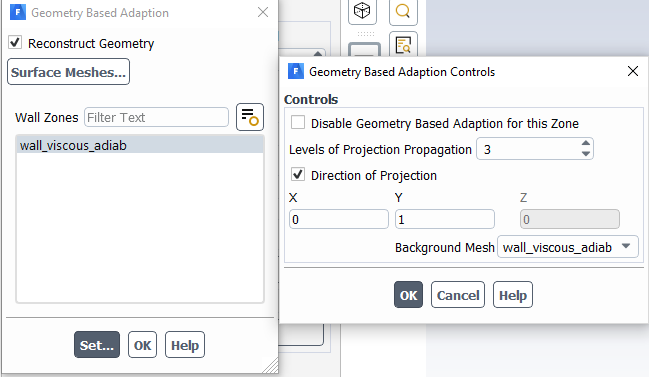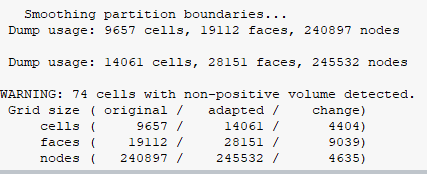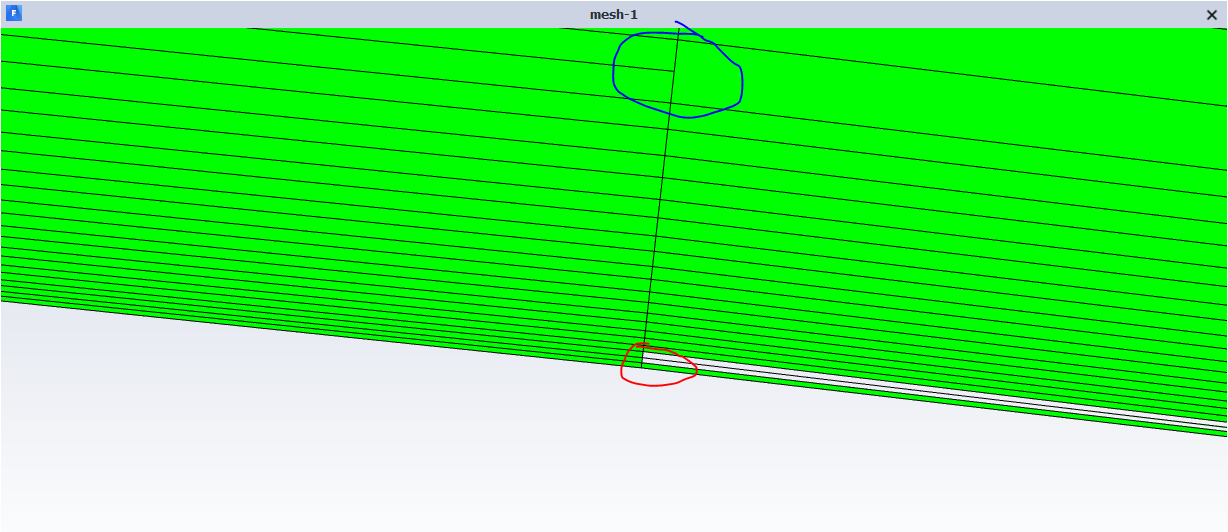TAGGED: adapt, adaption, fluent, gradient-adaption, mesh-adaption
-
-
July 29, 2021 at 8:59 pm
vedama
SubscriberI'm attempting to adapt a relatively simple geometry using the Geometry adaption. I imported a very fine mesh as a background mesh and attempted to adapt a very coarse mesh based on a combination of field variables and gradients. However. the adaption algorithm leads to the formation of left-handed faces and negative volume cells as you can see in the image:
July 30, 2021 at 11:05 amRob
Forum ModeratorYou're trying to adapt an overset zone? It's clear why/how you've got a fine mesh but are trying to adapt a coarse mesh.
July 30, 2021 at 6:53 pmvedama
SubscriberHi Rob No, this is not an overset zone. It's a very simple 2D geometry. I used a fine mesh as the surface background mesh as seen below:

To my understanding, the coarse mesh will use the background mesh as a stencil to adapt toward. However, when I run the adapt function based on some field variables, it creates negative volumes.
July 30, 2021 at 9:17 pmAugust 2, 2021 at 2:44 pmRob
Forum ModeratorI suspect the cell aspect ratio is partly to blame, and when you adapt it the solver is twisting the result. What, and why are you trying to adapt for?
August 2, 2021 at 3:57 pmvedama
SubscriberIt's flow over an axisymmetric airfoil. I have a very fine, grid-independent result that has a lot of cells. I'm trying to arrive at the same result with fewer cells. I start with a coarse grid and adapt the solution using pressure, density and velocity gradients, and also allowing the geometry to adapt based on the grid-independent solution so the curvature of the airfoil is accurately captured.
August 3, 2021 at 1:25 pmRob
Forum ModeratorI suspect you're pushing the tolerances and the solver is struggling to place the cell centre in the cell as opposed to in an adjacent cell. Are you using double precision?
August 3, 2021 at 3:31 pmvedama
SubscriberI am using double precision, yes. Is there a way to fix the tolerance issue and test?
August 4, 2021 at 11:09 amRob
Forum ModeratorNo, I suspect you've just got too fine a mesh and may be trying to refine through an adjacent cell.
August 4, 2021 at 4:05 pmvedama
SubscriberI'm not sure I understand. Are you saying my background mesh is too fine? My background mesh is supposed to be just the wall boundary of the airfoil. Is my procedure/thought process incorrect? I'm happy to provide more details, if needed.
August 5, 2021 at 12:11 pmRob
Forum ModeratorCan you check the rest of the projection settings? https://ansyshelp.ansys.com/account/Secured?returnurl=/Views/Secured/corp/v212/en/flu_th/x1-100600020.10.1.html Read the Guidelines section here if you don't know how to access help links). It's not a function I use but you could have too fine an inflation for the node move to avoid twisting cells.
Viewing 10 reply threads- The topic ‘Fluent Geometry Adaption Negative Volume Left-Handed Faces/Cells’ is closed to new replies.
Innovation SpaceTrending discussionsTop Contributors-
4618
-
1530
-
1386
-
1209
-
1021
Top Rated Tags© 2025 Copyright ANSYS, Inc. All rights reserved.
Ansys does not support the usage of unauthorized Ansys software. Please visit www.ansys.com to obtain an official distribution.
-
The Ansys Learning Forum is a public forum. You are prohibited from providing (i) information that is confidential to You, your employer, or any third party, (ii) Personal Data or individually identifiable health information, (iii) any information that is U.S. Government Classified, Controlled Unclassified Information, International Traffic in Arms Regulators (ITAR) or Export Administration Regulators (EAR) controlled or otherwise have been determined by the United States Government or by a foreign government to require protection against unauthorized disclosure for reasons of national security, or (iv) topics or information restricted by the People's Republic of China data protection and privacy laws.













